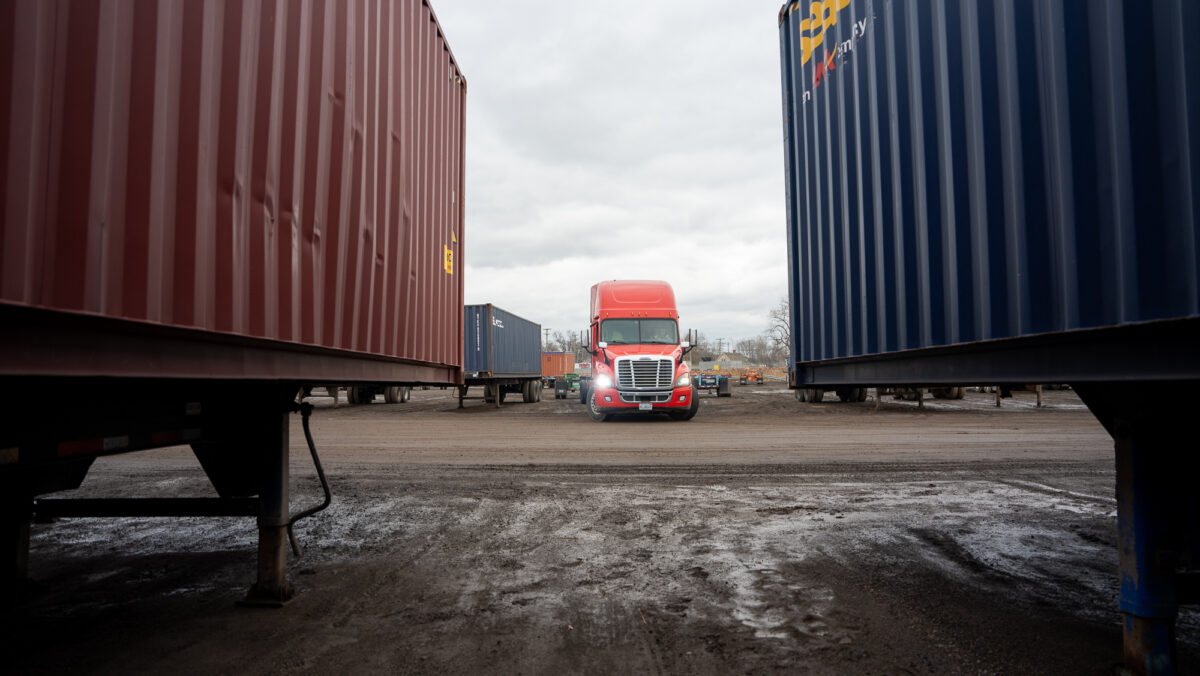Overview:
-Southwest Detroit residents have endured noise and pollution from truck traffic for generations.
-An ordinance being developed by the city would reroute trucks away from neighborhood streets and onto roads like Michigan Avenue and Livernois Avenue.
-A Hubbard Farms resident says directing traffic from intermodal facilities to highways is the "real issue."
By summer, Detroit plans to enact the truck route ordinance for which Southwest Detroit residents have petitioned since 1938. The ordinance aims to reduce truck traffic and associated pollution in residential areas by establishing designated routes.
Southwest Detroit residents have endured generations of pollution, noise, and dust from truck traffic serving dozens of intermodal facilities and heavy industry in and around residential areas.
The Ambassador Bridge is crossed by around 10,000 trucks a day, adding to diesel exhaust pollution, which contains particulate matter associated with heart and lung problems and pollutants like nitrogen oxides, which are significant drivers of pollution-related deaths.
Augusta Gudeman, freight infrastructure specialist with the City of Detroit, outlined plans for the rollout, education, and enforcement tied to the ordinance at a March 12 Southwest Detroit Environmental Vision meeting with residents.
“I can’t promise that we’re going to 100% get it passed at that time, but that is what we’re aiming for,” Gudeman said of the city’s summer timeline.
What the truck ordinance means for Southwest Detroit
The proposed truck routes prioritize major arteries like Michigan Avenue, keeping trucks away from dense residential areas like Clark Street, Scotten Street, and Toledo Street.
Once the ordinance is signed into law, new signage will clearly mark the routes trucks can or cannot travel, Gudeman said, and police will issue citations and fines to trucks and companies breaking the law.
The community will need to alert the city of any issues with signage or to report a truck traveling on a restricted road, she said. The exact reporting method is still being developed.
“We don’t have a streamlined way of taking in information and feedback specifically related to trucks,” Gudeman said. “We’re going to create something that’s a little clearer for folks to use, so we’ve got better data to understand the issues that are emerging.”
Throughout 2025 and beyond, the city will continue to educate residents, businesses, and truck drivers, Gudeman said. The city asked residents to weigh in on truck route ordinance language, new street and signage designs, new intersection designs, and enhanced street sweeping operations, she said.
Robert Andersen, 20-year Hubbard Farms resident, said in an area where “you can see [pollution] residue on patio furniture,” directing traffic from intermodal facilities onto the highway, instead of residential areas, is the “real issue.”
Andersen moved to Southwest just as the exchange for the Ambassador Bridge was rerouted from residential areas to the freeway.
“That helped out quite a bit,” Andersen said. “It’s pretty remarkable. Over the last 20 years, the quality of life has gotten better.”
Andersen said the neighborhood is “vigilant” and when something doesn’t seem right, residents question it immediately.
“Our corporate neighbors are always looking for an opportunity to push things a little further that might put the neighborhood at risk, but we do push back,” he said.
The Ambassador Bridge, built in 1929, carries about 25% of the vehicular traffic between the U.S. and Canada, according to an environmental assessment by its owner, the Detroit International Bridge Company.
How Southwest Detroit truck traffic could be rerouted
Southwest Detroit is home to more than a dozen major generators of freight activity, such as the Ambassador Bridge, the Detroit Produce Terminal, and Oasis Trucking, last year’s city truck route study states. Many large freight generators are near interstates, but some are located in or near residential areas.
Among the top freight generators is the Detroit Intermodal Freight Terminal, a key trade hub for local and international travel housing operations for rail, shipping containers, and trucking. The facility clocks nearly 2,000 trucks a day at one of its entrances on Federal Street, according to daily averages counted by a camera between October and December 2022 in the city’s study.
Local traffic from trucks traveling to and from industrial and logistics facilities along the Norfolk Southern railroad line, which runs east-west between the Michigan Martin and Springwells neighborhoods in Southwest, may have a harder time with their current route under the proposed ordinance.
The ordinance identifies “issue routes” in Southwest Detroit. These are streets with known or expected truck traffic in sensitive areas, like homes, schools, parks, and community centers.
In order to defray truck travel on the issue routes, the following road segments would likely experience increased truck volumes once the ordinance is in effect, according to the city:
- Michigan Avenue: Livernois Avenue to southbound I-75 Service Drive.
- Livernois Avenue: I-94 to Vernor Highway.
- I-75/Fisher Service Drive: Michigan Avenue to West Grand Boulevard.
- Vernor Highway: Waterman Street to Livernois Avenue.
- John Kronk Street/Southern Avenue: Wyoming Avenue to Livernois Avenue.
- West Grand Boulevard: Martin Luther King Jr. Boulevard to Michigan Avenue.
- Martin Luther King Jr. Boulevard: I-96 Service Drive to West Grand Boulevard.
Michael Belzer, professor of economics at Wayne State University, said the expected smooth flow of traffic depends on broader economic conditions. With an economic downturn and trade tensions at hand, truck traffic might decrease overall, Belzer said.
“What you notice when you have recessions, is that there’s no traffic jams anymore,” Belzer said. “[Tariffs] would cut the number of trucks going across the bridge, because there’s nothing to haul.”
MORE REPORTING ON SOUTHWEST DETROIT
$3.2M federal grant aids Southwest Detroit nonprofit in replacing diesel trucks with cleaner options
Southwest Detroit Environmental Vision received a $3.2 million federal grant to replace 57 diesel trucks and a tugboat with cleaner options, cutting diesel emissions and enhancing air quality in the community.
$112 million project promises cleaner air, less truck traffic in southwest Detroit
The Detroit Intermodal Freight Terminal will spend $112 million to modernize and decarbonize, reducing truck traffic and air pollution. However, residents and advocates question if the changes will address community concerns or just expand the terminal’s capacity at their expense.
Southwest Detroit remembers lives lost to air pollution ahead of Dia de Los Muertos
Residents and environmental justice groups gathered in Clark Park on November 1, 2024, to honor lives lost to air pollution during Día de los Muertos, demanding cleaner air and environmental justice in Southwest Detroit.
The Gordie Howe bridge and Southwest Detroit traffic
The Windsor-Detroit Bridge Authority says the Gordie Howe Bridge is on track to open to traffic this fall. The Canadian government funded the new international border crossing, which is located in Delray on the U.S. side of the Detroit River. It will compete for truck traffic with the privately owned Ambassador Bridge, which links I-75 and I-96 in the U.S. with Highway 3 in Ontario.
An estimated 8,000 commercial vehicles will utilize the new bridge on an average weekday once the bridge opens this year, mainly by redistributing trips from the Ambassador Bridge, according to a 2018 report for the Michigan Department of Transportation.
By 2040, average weekday volumes are projected to grow to 10,766 commercial vehicles.
A 2021 University of Windsor study found the Gordie Howe bridge would save truckers 850,000 hours of wait time, and trucking companies billions of dollars, over the bridge’s lifespan.
Changes in activity in the new bridge area can already be observed today, according to a July 2024 Southwest Detroit truck route study commissioned by the city.
Existing and new industrial users are expanding or building facilities in Delray and Southwest to take advantage of the new bridge, according to the study.
“Along with planned trips originating from local access points on the new service plaza, these new and expanded uses are anticipated to create new truck trips south of I-75 at minimum,” the report said.
The Gordie Howe bridge will be accessed from the freeway, not by local traffic, said Georgette Johnson, press secretary for the city.
Based on a map of proposed routes in the city’s ordinance, trucks coming from the intermodal facility to the new bridge would travel just under 5 miles along Livernois Avenue north to Michigan Avenue; onto the east I-96 service drive; to the I-75 service drive.
Once finished, the bridge will be the longest cable-stayed bridge in North America, stretching 1.5 miles across the Detroit River, according to the Federal Highway Administration. The cable-stayed bridge features six lanes, three in each direction, and incorporates lanes for cyclists and pedestrians.





